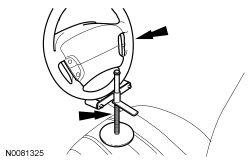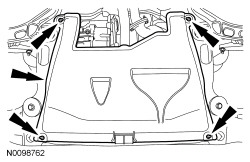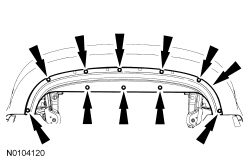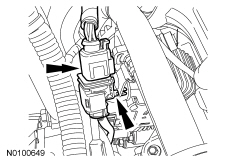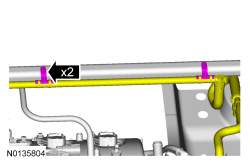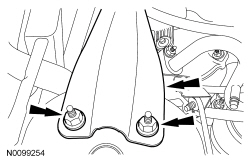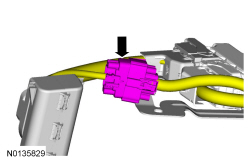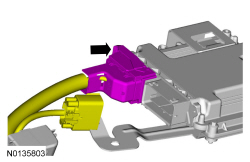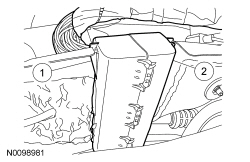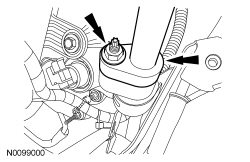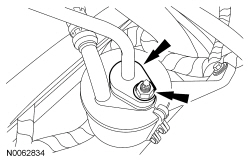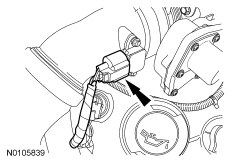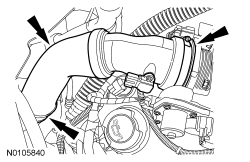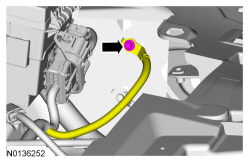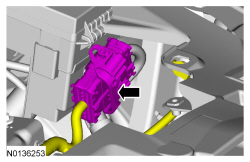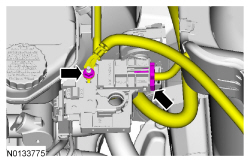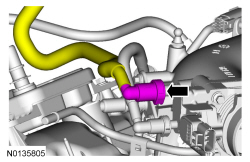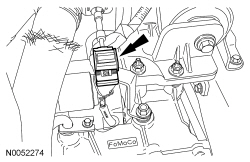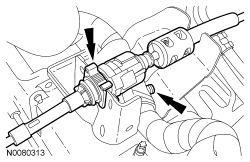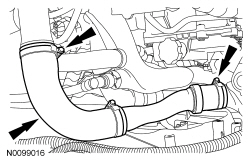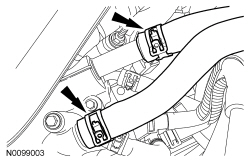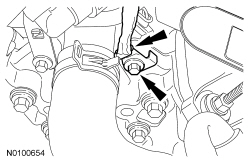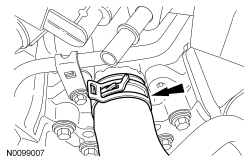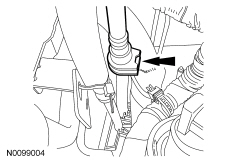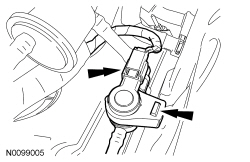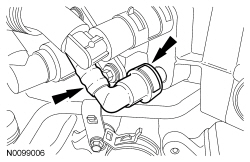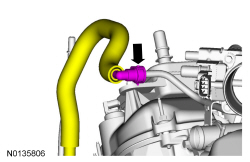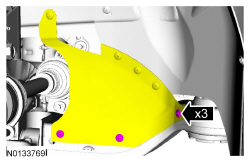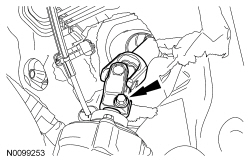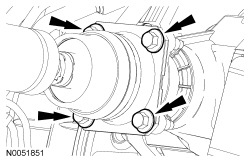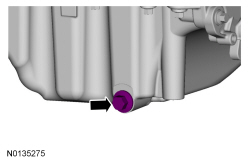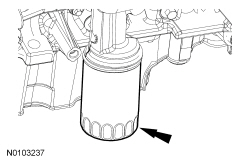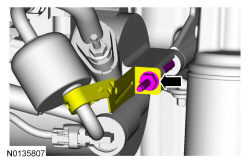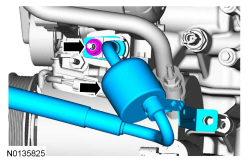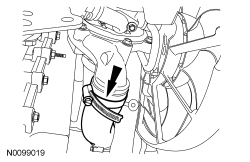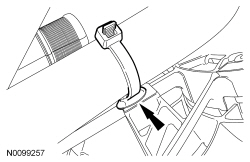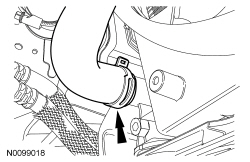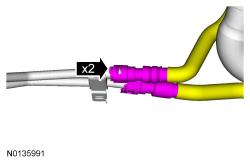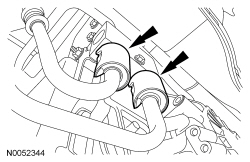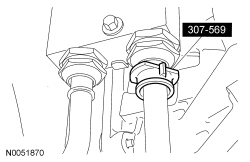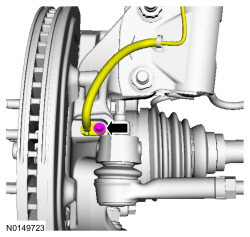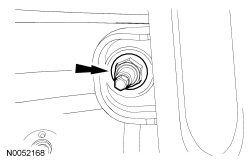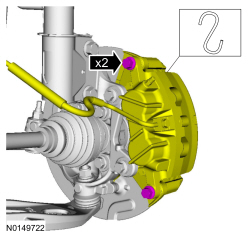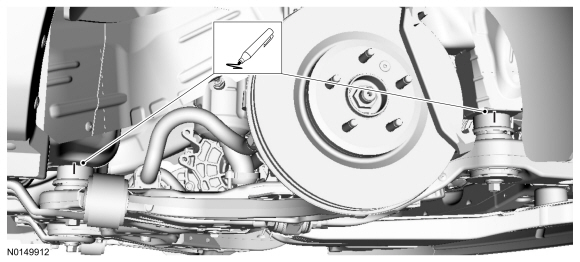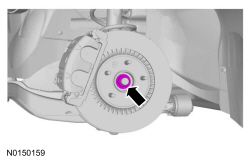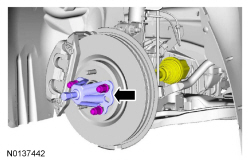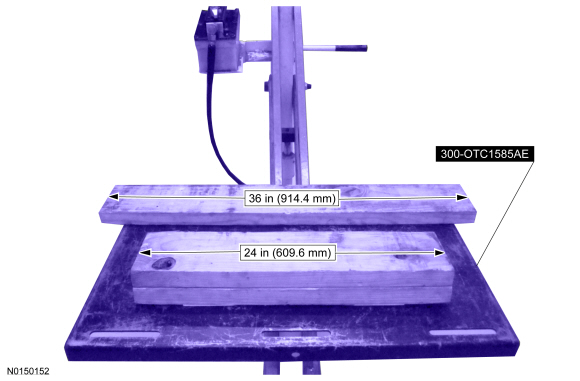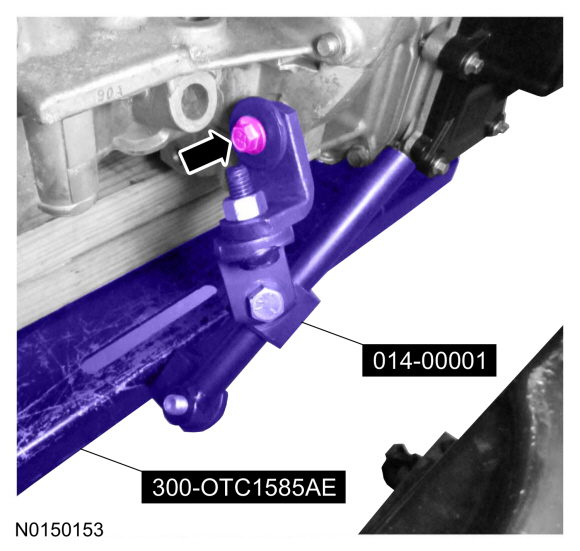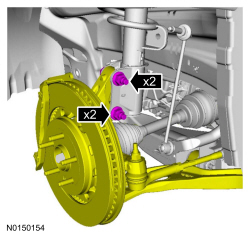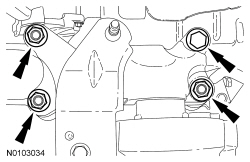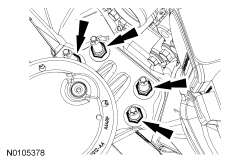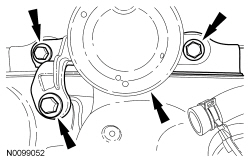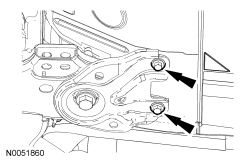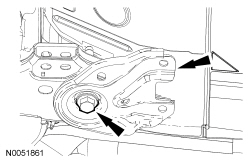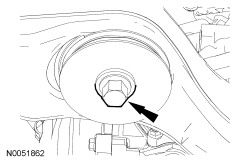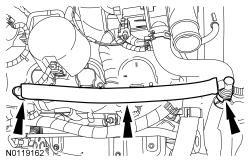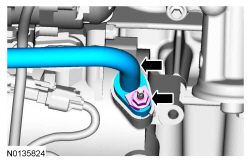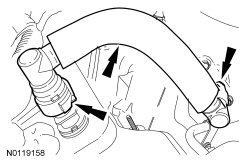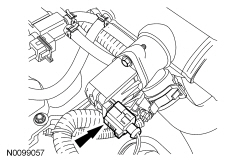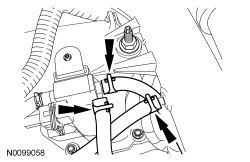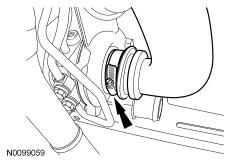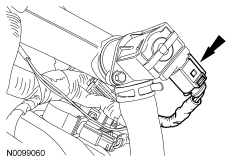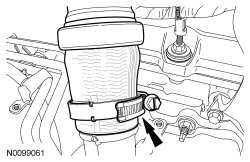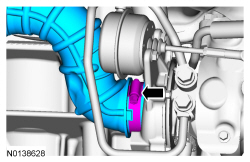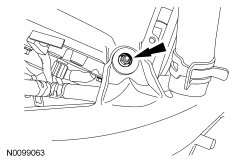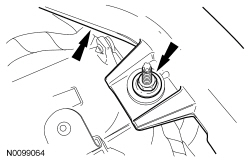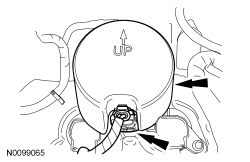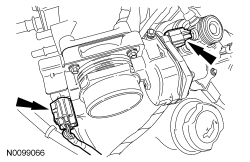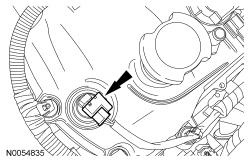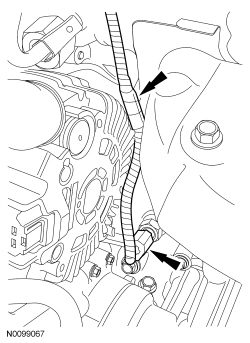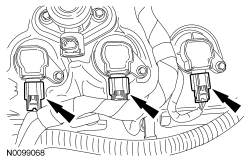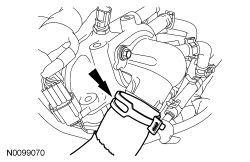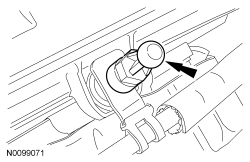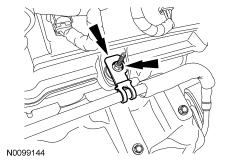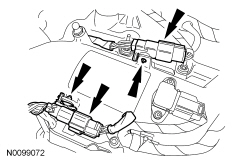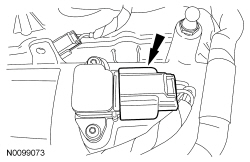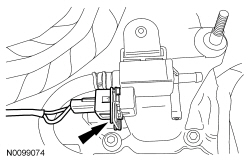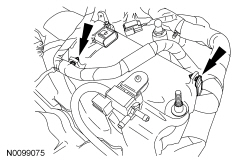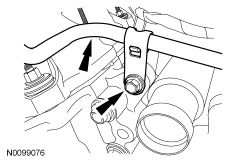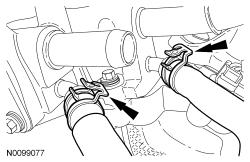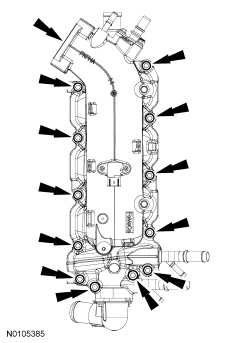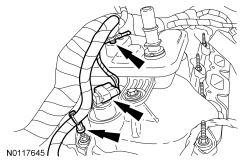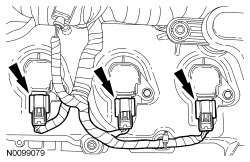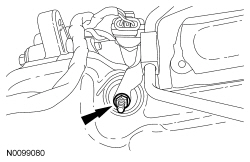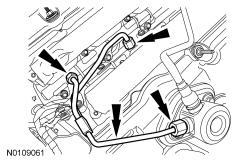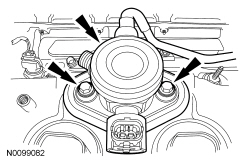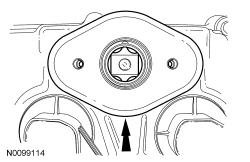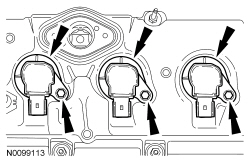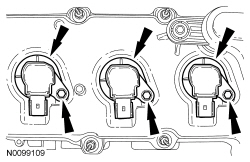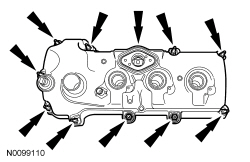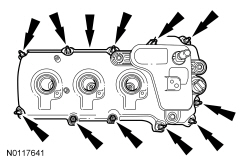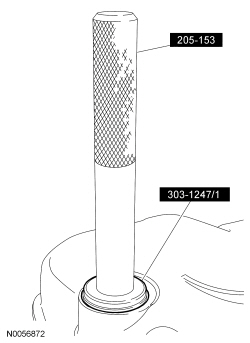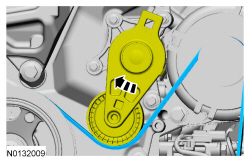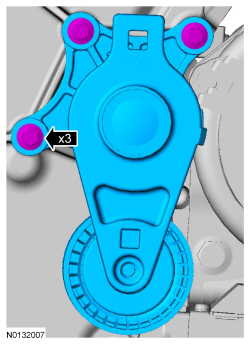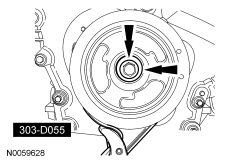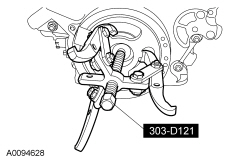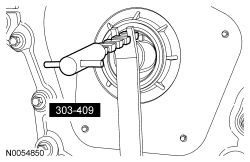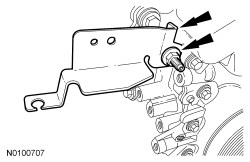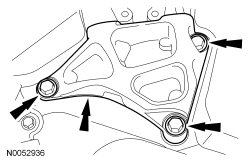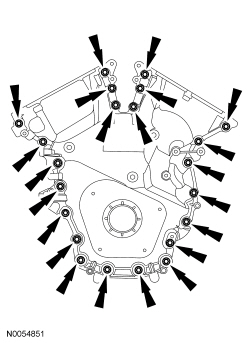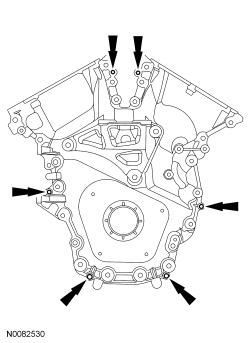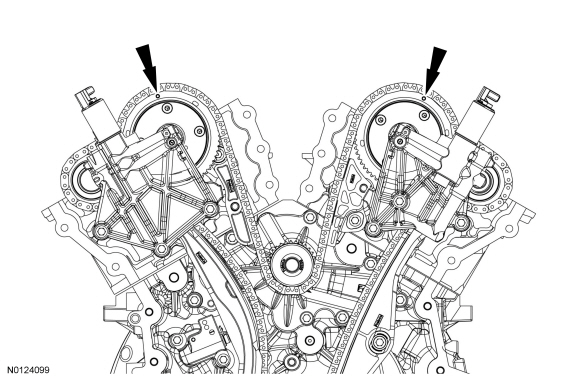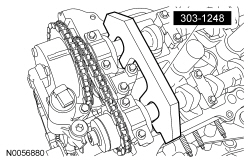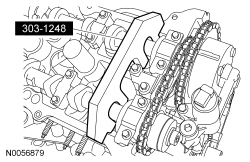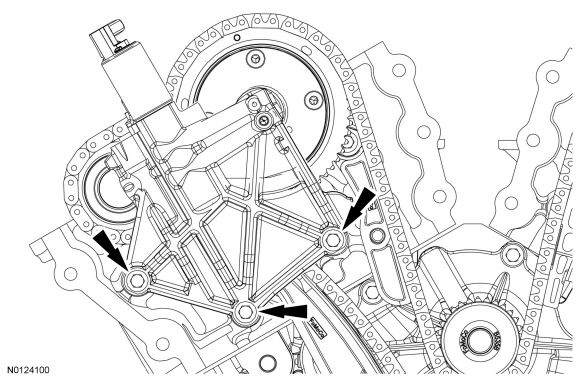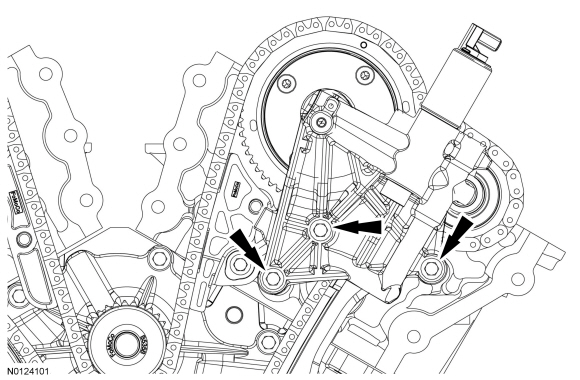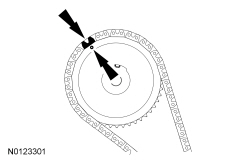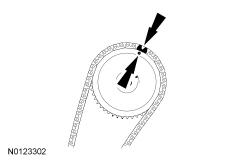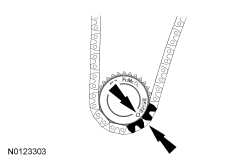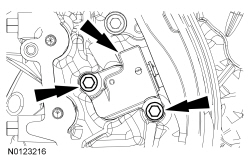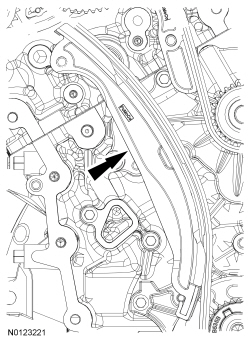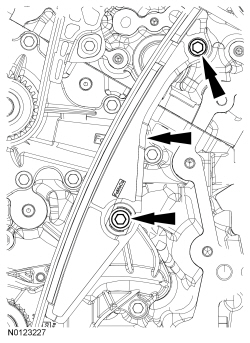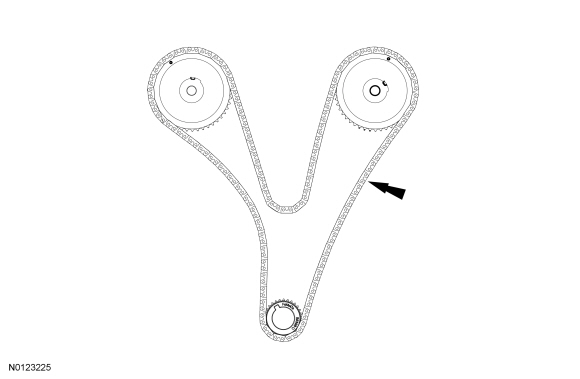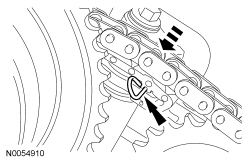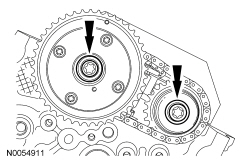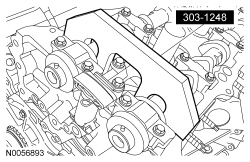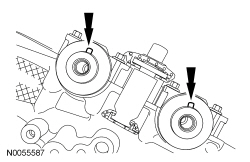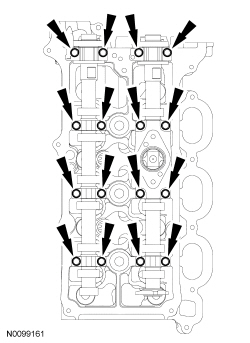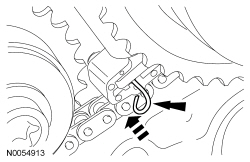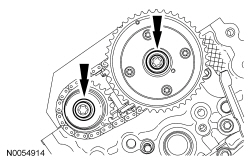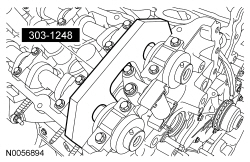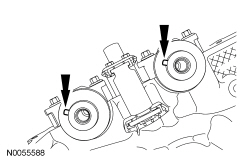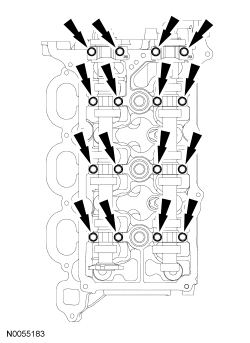SECTION 303-01B: Engine — 3.5L GTDI
| 2014 Flex Workshop Manual
|
REMOVAL
| Procedure revision date: 05/02/2013
|
Camshaft
Special Tool(s)
 | 3 Jaw Puller
303-D121 or equivalent
|
 | Adjustable Grip Arm, 1735A
014-00001 or equivalent
|
 | Disconnect Tool, Transmission Cooler Line
307-569
|
 | Handle
205-153 (T80T-4000-W)
|
 | Powertrain Lift
300-OTC1585AE or equivalent
|
 | Remover, Oil Seal
303-409 (T92C-6700CH)
|
 | Remover, VCT Spark Plug Tube Seal
303-1247/1
|
 | Strap Wrench
303-D055 (D85L-6000-A) or equivalent
|
 | Tool, Camshaft Holding
303-1248
|
Material
| Item
| Specification
|
|---|
Motorcraft® Metal Surface Prep
ZC-31-A
| —
|
Motorcraft® Silicone Gasket Remover
ZC-30
| —
|
Removal
 WARNING: Do not smoke, carry lighted tobacco or have an open flame of any type when working on or near any fuel-related component. Highly flammable mixtures are always present and may be ignited. Failure to follow these instructions may result in serious personal injury.
WARNING: Do not smoke, carry lighted tobacco or have an open flame of any type when working on or near any fuel-related component. Highly flammable mixtures are always present and may be ignited. Failure to follow these instructions may result in serious personal injury.
NOTICE:
During engine repair procedures, cleanliness is extremely important. Any foreign material, including any material created while cleaning gasket surfaces, that enters the oil passages, coolant passages or the oil pan may cause engine failure.
NOTICE:
Whenever turbocharger air intake system components are removed, always cover open ports to protect from debris. It is important that no foreign material enter the system. The turbocharger compressor vanes are susceptible to damage from even small particles. All components should be inspected and cleaned, if necessary, prior to installation or reassembly.
All camshafts
- With the vehicle in NEUTRAL, position it on a hoist. For additional information, refer to
Section 100-02
.
NOTE:
Use a steering wheel holding device (such as Hunter® 28-75-1 or equivalent).
Using a steering wheel holding device, hold the steering wheel in the straight-ahead position.
- Release the fuel system pressure. For additional information, refer to
Section 310-00
.
- Recover the A/C system. For additional information, refer to
Section 412-00
.
- Remove the front wheels and tires. For additional information, refer to
Section 204-04
.
- Remove the 4 retainers and the underbody shield.
- Remove the 3 pin-type retainers, 7 bolts and the front valance.
- Drain the cooling system. For additional information, refer to
Section 303-03
.
- Disconnect the LH Heated Oxygen Sensor (HO2S) electrical connector.
- Detach the
connector retainer from the bracket.
- Remove the cowl panel grille. For additional information, refer to
Section 501-02
.
- Detach the 2 brake booster vacuum hose retainers from the strut tower brace.
- Remove the 4 nuts (2 shown) and the strut tower brace.
- Disconnect the engine harness electrical connector.
- Disconnect the PCM electrical connector.
- Remove the engine wiring harness retainer from the bulkhead.
- Push the wiring harness retainer tab in.
- Slide the wiring harness up and out of the bulkhead.
- Remove the nut and disconnect the A/C tube.
- Discard the O-ring seal and gasket seal.
- Remove the nut and the A/C tube.
- Discard the O-ring seal and gasket seal.
- Remove the degas bottle. For additional information, refer to
Section 303-03
.
- Remove the engine Air Cleaner (ACL) and
outlet pipe. For additional information, refer to
Section 303-12
.
- Disconnect the Turbocharger Boost Pressure (TCBP)/Charge Air Cooler Temperature (CACT) sensor electrical connector.
- Loosen the 2 clamps and remove the
outlet pipe.
- Remove the battery tray. For additional information, refer to
Section 414-01
.
- Remove the bolt and the ground wire.
- Disconnect the engine wire harness electrical connector.
- Remove the nut and disconnect the power feed wire from the positive battery terminal.
- Disconnect the electrical connector.
- Disconnect the brake booster vacuum quick connect coupling from the intake manifold. For additional information, refer to
Section 310-00
.
- Disconnect the transaxle control cable from the control lever.
- Disconnect the transaxle control cable from the shift cable bracket.
- Detach the wiring harness pin-type retainer.
- Loosen the 2 clamps and remove the RH
tube.
- Disconnect the 2 heater hoses from the intake manifold.
- Remove the bolt and ground wire from the engine front cover.
- Disconnect the upper radiator hose from the intake manifold coolant tube.
- If equipped, detach the engine block heater harness from the radiator support wiring harness.
- Disconnect the Evaporative Emission (EVAP) tube quick connect coupling. For additional information, refer to
Section 310-00
.
- Disconnect the
valve electrical connector and detach from the intake manifold.
- Disconnect the quick connect coupling from the intake manifold and remove the
tube assembly. For additional information, refer to
Section 310-00
.
- Disconnect the fuel supply tube. For additional information, refer to
Section 310-00
.
- Remove the 3 pin-type retainers and position aside.
- Remove the LH and RH catalytic converters. For additional information, refer to
Section 309-00
.
NOTICE:
Do not allow the intermediate shaft to rotate while it is disconnected from the gear or damage to the clockspring may occur. If there is evidence that the intermediate shaft has rotated, the clockspring must be removed and recentered. For additional information, refer to
Section 501-20B
.
Remove the bolt and disconnect the steering column shaft from the steering gear.
NOTE:
Index-mark the driveshaft for installation.
Remove and discard the 4 bolts and position aside the driveshaft.
- Remove the drain plug and drain the engine oil.
- Install the drain plug and tighten to 27 Nm (20 lb-ft).
- Remove and discard the engine oil filter.
- Remove the A/C tube bracket bolt from the rear of the compressor.
- Remove the nut and disconnect the upper A/C tube from the compressor.
- Discard the O-ring seal and gasket seal.
- Loosen the clamp and disconnect the lower LH
tube from the LH turbocharger.
- Detach the lower radiator hose retainer from the cooling fan and shroud.
- Disconnect the lower radiator hose from the radiator.
- If equipped, disconnect the 2
coolant hoses.
- Remove the 2 secondary latches from the transmission fluid cooler tubes at the transmission fluid cooler thermal bypass valve.
- Using the Transmission Cooler Line Disconnect Tool, disconnect the transmission fluid cooler tubes from the transmission fluid cooler thermal bypass valve.
NOTE:
LH shown, RH similar.
Remove the bolt and the wheel speed sensor.
NOTE:
RH shown, LH similar.
Remove and discard the upper stabilizer link nuts.
NOTICE:
Do not allow the brake caliper to hang from the brake flexible hose or damage to the hose may occur.
NOTE:
LH shown, RH similar.
Remove the brake caliper guide pin bolts and calipers.
NOTE:
RH shown, LH similar.
Using a wax pencil, mark the relationship of the front and rear subframe to the underbody at the mounting locations on both side.
NOTE:
LH shown, RH similar.
Remove the LH and RH halfshaft nuts.
- Do not discard at this time.
NOTE:
LH shown, RH similar.
Separate the LH and RH halfshaft from the wheel hubs.
- Position a 2 x 6 board, 36 in (914.4 mm) in length and two 2 x 6 boards 24 in (609.6 mm) in length onto the powertrain lift.
- Position the powertrain lift table with:
- the long board towards the rear of the subframe.
- the short boards under the engine and transmission.
- Install the Adjustable Grip Arm from the powertrain lift table to the LH engine-to-transmission bolt hole.
- Install a ratchet strap from the front of the subframe under the powertrain lift table to the rear of the subframe, to secure the subframe to the powertrain lift table.
NOTE:
LH shown, RH similar.
NOTE:
The halfshafts are not being remove from the transmission.
Remove the strut-to-wheel knuckle nuts and bolts.
- Remove the strut from the wheel knuckle and the halfshafts from the wheel knuckle.
- Remove the 3 nuts and the bolt from the transaxle support insulator bracket-to-transaxle.
- Remove the 4 engine mount nuts.
- Remove the 3 bolts and the engine mount.
NOTE:
RH shown, LH similar.
Remove the subframe bracket-to-body bolts.
NOTE:
RH shown, LH similar.
Remove the rear subframe bolts and the subframe brackets.
NOTE:
RH shown, LH similar.
Remove the front subframe bolts.
- Lower the subframe and powertrain assembly from the vehicle.
- Disconnect the 2 quick connect couplings and remove the crankcase vent tube. For additional information, refer to
Section 310-00
.
- Remove the nut and the A/C tube from the compressor.
- Discard the O-ring seal and gasket seal.
- Disconnect the 2 quick connect couplings and remove the PCV tube. For additional information, refer to
Section 310-00
.
- Disconnect the LH turbocharger bypass valve electrical connector.
NOTE:
Index-mark the hoses for installation.
Disconnect the turbocharger wastegate regulating valve hoses from the RH
tube and turbocharger wastegate regulating valve.
- Loosen the clamp and remove the LH turbocharger intake tube from the LH turbocharger.
- Disconnect the RH turbocharger bypass valve electrical connector.
- Loosen the clamp and remove the RH
tube from the RH turbocharger.
- Loosen the clamp and remove the RH turbocharger intake pipe from the RH turbocharger.
NOTICE:
The compression limiter bushing may fall out of the mounting bracket grommet on the turbocharger intake tube during service. Make sure the bushing is in place when reinstalling the tube or damage to the tube may occur.
Remove the nut from the RH valve cover stud bolt for the RH turbocharger intake tube.
NOTICE:
The compression limiter bushing may fall out of the mounting bracket grommet on the Charge Air Cooler (CAC) tube during service. Make sure the bushing is in place when reinstalling the tube or damage to the tube may occur.
Remove the RH
tube nut from the intake manifold and remove the RH
tube and turbocharger intake tube as an assembly.
- Remove the noise insulator shield for the fuel injection pump and disconnect the electrical connector.
- Disconnect the Throttle Position (TP) sensor and electronic
electrical connectors.
- Disconnect the LH Variable Camshaft Timing (VCT) solenoid electrical connector.
- Disconnect the Engine Oil Pressure (EOP) electrical connector.
- Detach the wiring harness retainer from the block.
- Disconnect the 3 LH ignition coil-on-plug electrical connectors.
- Remove the lower radiator hose from the thermostat housing.
- Remove the engine cover mounting stud from the LH valve cover stud bolt.
- Detach all the wiring harness retainers from the LH valve cover and stud bolts.
- Remove the nut and the oil supply tube bracket from the LH valve cover stud bolt.
- Remove the oil level indicator.
- Detach and disconnect the 2 fuel injector wiring harness electrical connectors.
- Disconnect the Manifold Absolute Pressure (MAP)/Intake Air Temperature 2 (IAT2) sensor electrical connector.
- Disconnect the turbocharger wastegate regulating valve electrical connector.
- Detach the 2 wire harness-to-intake manifold retainers.
- Remove the fuel tube-to-engine front cover bracket bolt and position the fuel tube aside.
- Disconnect the 2 turbocharger coolant hoses from the intake manifold.
NOTICE:
If the engine is repaired or replaced because of upper engine failure, typically including valve or piston damage, check the intake manifold for metal debris. If metal debris is found, install a new intake manifold. Failure to follow these instructions can result in engine damage.
NOTE:
Note the routing of the 2 fuel rail wiring harnesses for installation.
Remove the 12 bolts and the intake manifold.
- Remove and discard the intake manifold, coolant crossover and thermostat housing gaskets.
- Clean and inspect all sealing surfaces.
- Disconnect the RH
solenoid electrical connector and detach the 2 wiring harness retainers.
- Disconnect the 3 RH ignition coil-on-plug electrical connectors.
- Detach all the wiring harness retainers from the RH valve cover and stud bolts.
- Remove the nut for the high pressure fuel tube from the LH valve cover stud bolt.
NOTE:
To release the fuel pressure in the high pressure fuel tube, wrap the flare nuts with a shop towel to absorb any residual fuel pressure during the loosening of the flare nuts.
Remove the high pressure fuel tube flare nut from the fuel injection pump. Remove the 2 high pressure fuel tube flare nuts from the fuel rails and remove the high pressure fuel tube assembly.
- Remove the 2 bolts and the fuel injection pump.
- Remove the fuel injection pump mounting plate.
NOTE:
Valve cover is removed for clarity.
Remove the fuel injection pump roller tappet.
- Inspect the fuel injection pump roller tappet. For additional information, refer to
Section 303-04B
.
NOTE:
When removing the ignition coil-on-plugs, a slight twisting motion will break the seal and ease removal.
Remove the 3 bolts and the 3 LH ignition coil-on-plugs.
NOTE:
When removing the ignition coil-on-plugs, a slight twisting motion will break the seal and ease removal.
Remove the 3 bolts and the 3 RH ignition coil-on-plugs.
- Loosen the 10 stud bolts and remove the LH valve cover.
- Loosen the 11 stud bolts and remove the RH valve cover.
NOTE:
solenoid seal removal shown, spark plug tube seal removal similar.
Inspect the
solenoid seals and the spark plug tube seals. Install new seals if damaged.
- Using the
Spark Plug Tube Seal Remover and Handle, remove the seal(s).
- Rotate the accessory drive belt tensioner clockwise and remove the accessory drive belt.
- Remove the 3 bolts and the accessory drive belt tensioner.
- Using the Strap Wrench, remove the crankshaft pulley bolt and washer.
- Using the 3 Jaw Puller, remove the crankshaft pulley.
- Using the Oil Seal Remover, remove and discard the crankshaft front seal.
- Remove the Heated Oxygen Sensor (HO2S) connector bracket stud bolt from the engine front cover.
- Remove the 3 bolts and the engine mount bracket.
- Remove the 22 engine front cover bolts.
- Install 6 of the engine front cover bolts (finger-tight) into the 6 threaded holes in the engine front cover.
- Tighten the bolts one turn at a time in a crisscross pattern until the engine front cover-to-cylinder block seal is released.
- Remove the engine front cover.
NOTICE:
Only use a 3M™ Roloc® Bristle Disk (2-in white, part number 07528) to clean the engine front cover. Do not use metal scrapers, wire brushes or any other power abrasive disk to clean the engine front cover. These tools cause scratches and gouges that make leak paths.
Clean the engine front cover using a 3M™ Roloc® Bristle Disk (2-in white, part number 07528) in a suitable tool turning at the recommended speed of 15,000 rpm.
- Thoroughly wash the engine front cover to remove any foreign material, including any abrasive particles created during the cleaning process.
NOTICE:
Place clean, lint-free shop towels over exposed engine cavities. Carefully remove the towels so foreign material is not dropped into the engine. Any foreign material (including any material created while cleaning gasket surfaces) that enters the oil passages or the oil pan, may cause engine failure.
NOTICE:
Do not use wire brushes, power abrasive discs or 3M™ Roloc® Bristle Disk (2-in white, part number 07528) to clean the sealing surfaces. These tools cause scratches and gouges that make leak paths. They also cause contamination that will cause premature engine failure. Remove all traces of sealant, including any sealant from the inner surface of the cylinder block and cylinder head.
Clean the sealing surfaces of the cylinder heads, the cylinder block and the oil pan in the following sequence.
- Remove any large deposits of silicone or gasket material.
- Apply silicone gasket remover and allow to set for several minutes.
- Remove the silicone gasket remover. A second application of silicone gasket remover may be required if residual traces of silicone or gasket material remain.
- Apply metal surface prep, to remove any remaining traces of oil or coolant and to prepare the surfaces to bond. Do not attempt to make the metal shiny. Some staining of the metal surfaces is normal.
- Make sure the 2 locating dowel pins are seated correctly in the cylinder block.
- Rotate the crankshaft clockwise and align the timing marks on the Variable Camshaft Timing (VCT) assemblies as shown.
NOTE:
The Camshaft Holding Tool will hold the camshafts in the Top Dead Center (TDC) position.
Install the Camshaft Holding Tool onto the flats of the LH camshafts.
NOTE:
The Camshaft Holding Tool will hold the camshafts in the
position.
Install the Camshaft Holding Tool onto the flats of the RH camshafts.
- Remove the 3 bolts and the RH
housing.
- Remove the 3 bolts and the LH
housing.
NOTE:
The following 3 steps are for primary timing chains when the colored links are not visible.
- Mark the timing chain link that aligns with the timing mark on the RH intake
assembly as shown.
- Mark the timing chain link that aligns with the timing mark on the LH intake
assembly as shown.
NOTE:
The crankshaft sprocket timing mark should be between the 2 colored links.
Mark the 2 timing chain links that align with the timing mark on the crankshaft sprocket as shown.
- Remove the 2 bolts and the primary timing chain tensioner.
- Remove the primary timing chain tensioner arm.
- Remove the 2 bolts and the lower LH primary timing chain guide.
- Remove the primary timing chain.
LH camshafts
- Compress the LH secondary timing chain tensioner and install a suitable lockpin to retain the tensioner in the collapsed position.
NOTE:
The
bolt and the exhaust camshaft bolt must be discarded and new ones installed. However, the exhaust camshaft washer is reusable.
Remove and discard the LH
assembly bolt and the LH exhaust camshaft sprocket bolt.
- Remove the LH
assembly, secondary timing chain and the LH exhaust camshaft sprocket as an assembly.
NOTE:
When the Camshaft Holding Tool is removed, valve spring pressure will rotate the LH camshafts approximately 3 degrees to a neutral position.
Remove the Camshaft Holding Tool from the LH camshafts.
NOTICE:
The camshafts must remain in the neutral position during removal or engine damage may occur.
Verify the LH camshafts are in the neutral position.
NOTE:
Cylinder head camshaft bearing caps are numbered to verify that they are assembled in their original positions.
Remove the bolts and the LH camshaft bearing caps.
RH camshafts
- Compress the RH secondary timing chain tensioner and install a suitable lockpin to retain the tensioner in the collapsed position.
NOTE:
The
bolt and the exhaust camshaft bolt must be discarded and new ones installed. However, the exhaust camshaft washer is reusable.
Remove and discard the RH
assembly bolt and the RH exhaust camshaft sprocket bolt.
- Remove the RH
assembly, secondary timing chain and the RH exhaust camshaft sprocket as an assembly.
- Remove the Camshaft Holding Tool from the RH camshafts.
NOTICE:
The camshafts must remain in the neutral position during removal or engine damage may occur.
Rotate the RH camshafts counterclockwise to the neutral position.
NOTE:
Cylinder head camshaft bearing caps are numbered to verify that they are assembled in their original positions.
Remove the bolts and the RH camshaft bearing caps.


















 WARNING: Do not smoke, carry lighted tobacco or have an open flame of any type when working on or near any fuel-related component. Highly flammable mixtures are always present and may be ignited. Failure to follow these instructions may result in serious personal injury.
WARNING: Do not smoke, carry lighted tobacco or have an open flame of any type when working on or near any fuel-related component. Highly flammable mixtures are always present and may be ignited. Failure to follow these instructions may result in serious personal injury.
